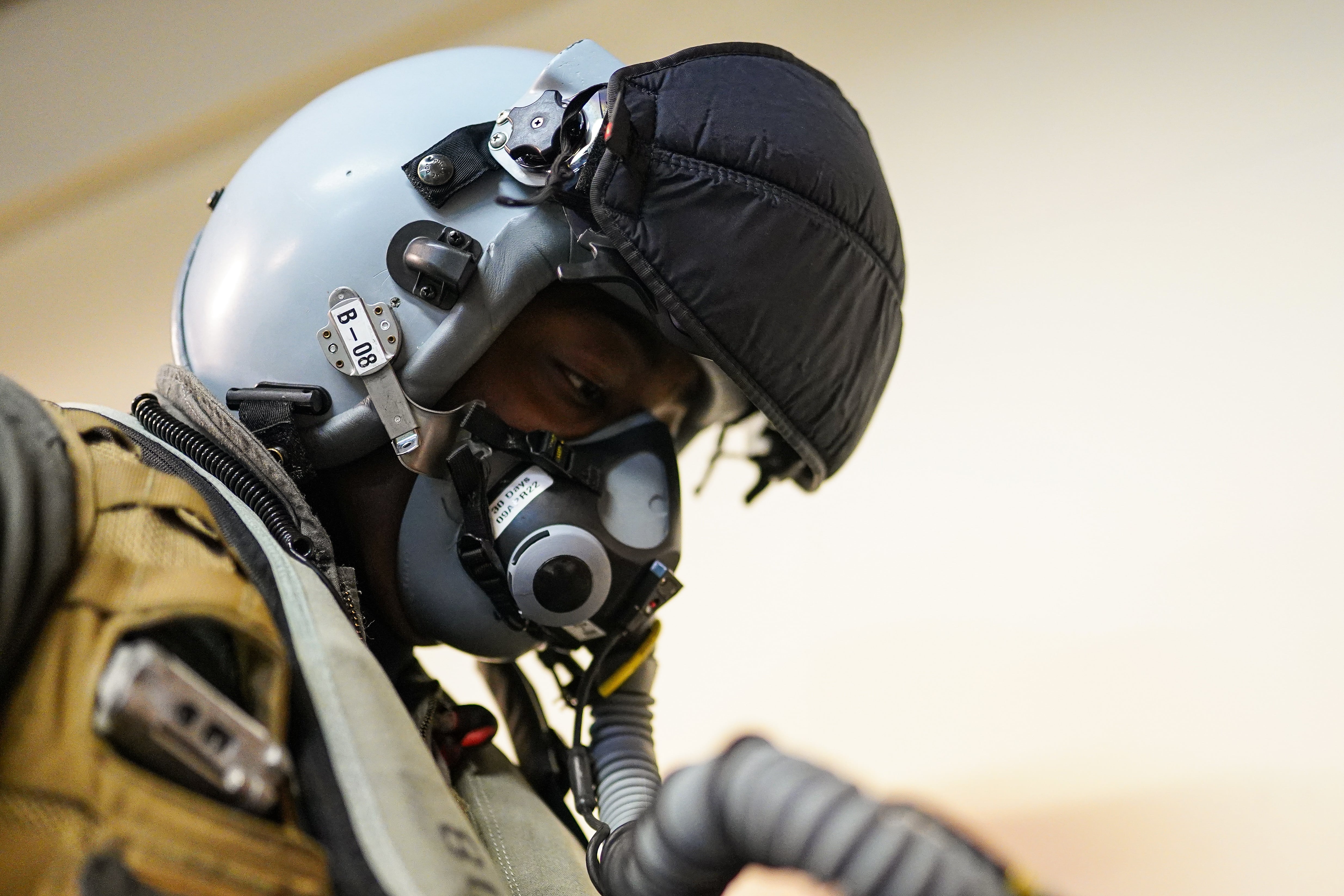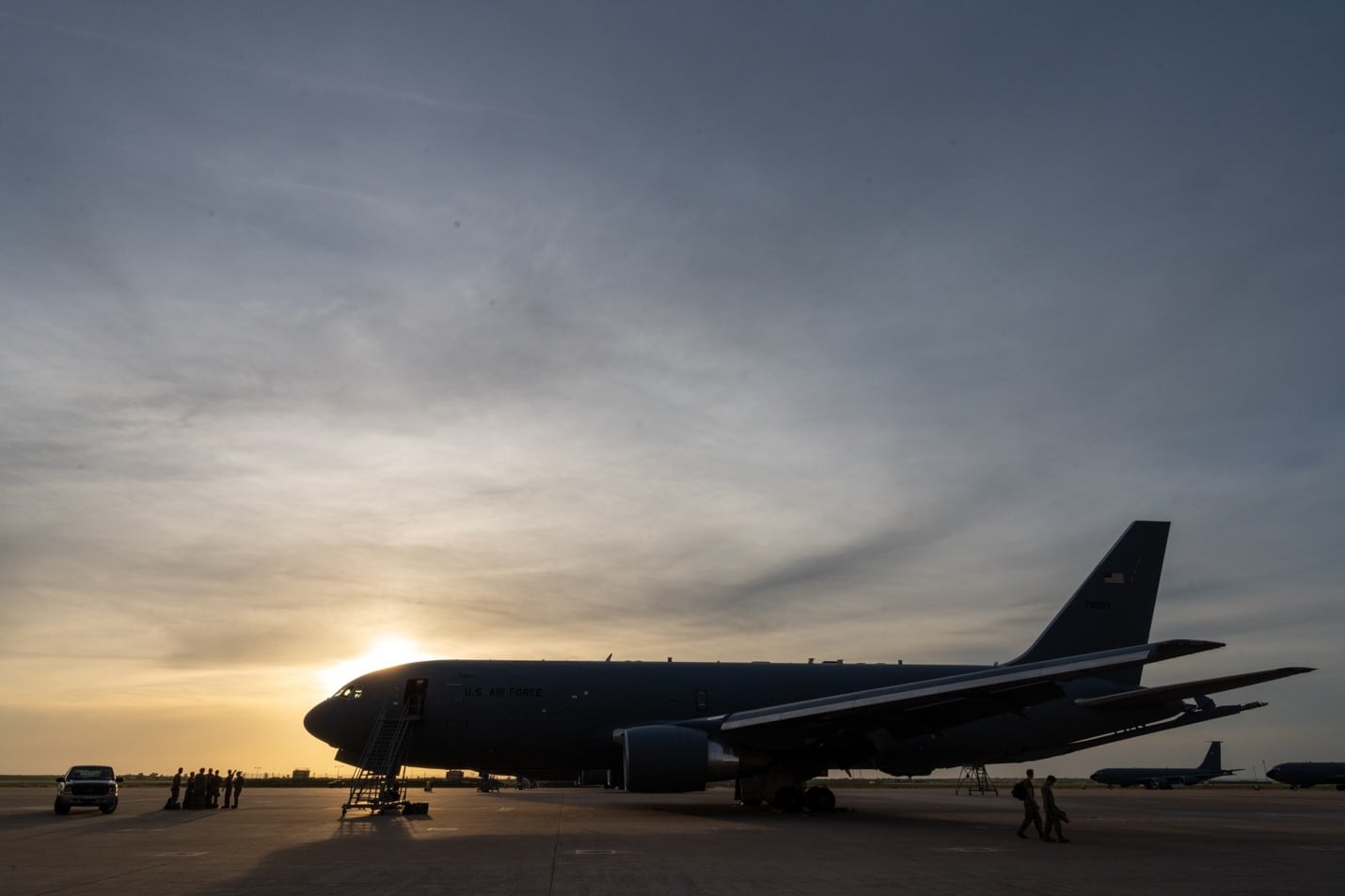Airmen are gearing up for what could be the most consequential move in military pilot training since the Air Force was created in 1947: teaching students to fly without stepping foot in a real airplane.
The new program, known as “Air Mobility Fundamentals-Simulator,” is the Air Force’s next step in a yearslong attempt to modernize pilot training without sacrificing quality. It’s also an opportunity for the service to embrace more cost-effective technology and retire its 30-year-old fleet of T-1A Jayhawk trainer jets.
But experts warn that turning out experienced pilots is more complicated than trading an airworthy cockpit for a replica.
There’s a lot of value to a simulator, but there’s something fundamentally different when you’re up in the thin air,” said Heather Penney, a retired Air National Guard fighter pilot who now researches defense policy at the Mitchell Institute for Aerospace Studies. “There’s no do-overs, there’s no resets.”
RELATED

A new path
Here’s how it works: The first military aircraft a new student touches is the T-6A Texan II, as part of the undergraduate pilot training curriculum. Earning pilot’s wings in the T-6 takes about seven months, at which point a trainee is selected to continue on the fighter-bomber track or the mobility track.
About 900 students are picked for mobility-track pilot slots each year. Those airmen, who train to fly cargo and tanker aircraft as well as special operations and intelligence-gathering planes, typically spend about five months in the T-1 — an intermediate step toward their operational unit.
Those who pass the T-1 course then move on to learn about their assigned aircraft.

Starting in January, the interim step — known as specialized undergraduate pilot training — will use only simulators to teach more advanced flight skills in 75 days. That includes the current T-1 simulator and a newly designed, more generic virtual-reality cockpit from Redbird Flight Simulations.
“For the types of things that they do in the T-1, a sim is a great place to do that at a much lower operational cost,” Josh Harnagel, marketing vice president at Redbird, told Air Force Times.
Each undergraduate pilot training base will host eight Redbird systems and four legacy T-1 simulators, the Air Force said in September.
Vance Air Force Base, Oklahoma, got its first Redbird simulators in September. Columbus AFB, Mississippi, is slated to receive its sims by March 2023, and Laughlin AFB, Texas, expects its sims in July 2023.
Teaching would begin four to six months after systems are delivered. That means the redesigned course may not be fully implemented until early 2024.
Redbird’s custom-built faux T-1 cockpit uses software designed by SAIC and Lockheed Martin to closely, but not exactly, replicate the experience of flying the Jaybird.
Though the view outside the “airplane” is virtual, cameras on a headset let students see their own hands while they manipulate buttons and knobs. That makes the experience more realistic and useful than trying to move fake hands around a screen.
“The human mind is amazing at … suspending disbelief,” Harnagel said. “With a good instructor, you can do just about everything.”
Effective approach
Simulators can be very effective tools for teaching emergency procedures or scenarios that aren’t possible in the local area, said two military experts who spoke to Air Force Times. It lets students safely explore what the airplane’s software can do, and to practice potentially sensitive maneuvers out of public view.
And in systems that track where a pilot is looking or the order in which they hit certain buttons, sim technology can help grade their performance.

A new curriculum has been in the works for about a year.
“We started from the target back,” Col. Robert Moschella, who leads pilot training reform efforts at 19th Air Force, told Air Force Times in a recent interview. “We established what [skills and traits the Air Force] would be looking for. Then we built a syllabus using some of our new technology and what we’ve learned over the years.”
In particular, the course emphasizes how to use a flight management system, properly manage resources, fly without one engine, run autopilot and read takeoff and landing data, the Air Force said.
The Air Force vetted its plan in three small group trials at Joint Base San Antonio-Randolph, Texas. Judging by their performance later on in training, Moschella said there’s “no discernible difference” in quality compared to past students.
“I think we’re on the right track,” he said.
Airmen offered plenty of feedback so the companies could make the new sims realistic enough to teach the skills they need, Harnagel said.
“It’s all in relatively the right spot,” he said. “We use aircraft hardware where it makes sense, and then we use off-the-shelf commercial stuff where it makes sense to help reduce costs.”
Whether a simulator effectively stands in for live flight depends on its level of fidelity, whether physical, visual or mental. And how close that needs to come to the real thing depends on what a course is trying to impart.
For instance, a full-motion system can demonstrate what it feels like to land a helicopter on an uneven surface, said Tim Marler, a military training and technology expert at the federally funded think tank Rand Corp. Virtual-reality goggles can’t replicate those physical qualities.
Cost considerations
But if the objective is to teach decision-making under stress without feeling a physical impact, a VR headset could be a good fit compared to a costly full-motion simulator.

Efficiency also matters.
“You wouldn’t want to figure out where all the knobs, buttons and controls are while you’re in the air,” Marler said. “That’s just a waste of fuel. You can do that looking at a static picture.”
The Air Force has ordered 20 Redbird systems so far, Harnagel said. The company’s bespoke cockpits typically cost $300,000 to $500,000, including flight software.
That’s a fraction of the price of more advanced sims with the technology to replicate G forces, for instance. Those can run tens of millions of dollars apiece, which may not always offer enough bang for the buck.
“Ten percent [more fidelity] costs an extra, let’s say, $10 million,” Harnagel said. “There really is not a lot of benefit for somebody who’s a pilot already.”
Moving to a sim-only curriculum doesn’t necessarily mean the Air Force needs fewer instructors. It’s up to the experienced pilots to make sure students understand what they’re doing right in the sim, so they don’t accidentally adopt bad habits.
Once up and running, the new approach won’t drastically change instructors’ responsibilities because the skill set is largely the same, Moschella said. His team is working to “train the trainers” before the first batch of student pilots begin at Vance in January.
“Instructor pilots will have to learn … how to use this [Redbird] device, how to turn it on, how to program it, how to set it up for a student profile,” he said. “It’ll just be another medium.”
The Air Force declined to make an instructor pilot available to discuss their expectations for the new program.
Concerns remain
Simulator instructors can become creatures of habit, especially those who feel bored or overworked, Penney argued. That could shortchange students who don’t get enough variety in their lessons.

“They will have pet scenarios that they do every time,” she said. “They’ll set the same weather, they’ll send you to the same airport, they’ll have the same wind, they’ll do the scenario in the same order. … Students can decode that quickly.”
That makes it even more important that students get airborne to practice under less-predictable conditions, including the possibility of a real crash.
“My main concern is, having talked with [Air Mobility Command boss Gen. Michael Minihan] and knowing that his vision for the future is” single-pilot missions, Penney said. “You’re going to have to find some way to absorb and experience these young kids before you can transition them to single-pilot ops.”
RELATED

Simulator training is nothing new elsewhere in the aviation industry. But Penney and Marler agreed that a mix of live flight and digital training is more effective than relying solely on aircraft or simulators.
“The military points towards the airlines, saying, ‘Look, people get their 737-type rating and the first time they ever actually touch the airplane is when they go on their [initial flight] and they’ve got 180 people in the back,” Penney said. “But don’t forget that that individual has, at a minimum, 1,500 hours of flight time and an air transport pilot rating.”
In comparison, Air Force pilots spend about 115 hours in real cockpits (around 18 hours at initial flight training in Colorado and 96 hours at undergraduate pilot training) before reaching the T-1. There, they log about 90 more hours, split between actual aircraft and sims.
They arrive at the formal training units for their assigned aircraft with about 160 airborne hours under their belts.
Penney is concerned about how that small amount of flight time, plus a few months of simulator-only training, will affect a student’s ability to think fast when something unexpected happens in midair.
“They will need to sit in the [co-pilot] seat for a long time as they get that real-world experience,” she said. “Weird things happen in the air, and real airplanes sometimes don’t do what they’re supposed to do.”
Hard realities
The changes come as the Air Force contends with steadily aging fleets and budgetary pressures. Those realities are driving the new training program more than a true desire to improve flight school, Penney said.
The Air Force plans to retire 156 T-1s between fiscal 2023 and 2025, including about 50 in the next year. If Congress approves, the move would shrink the total fleet from 178 aircraft to 127 by next October. Lawmakers appear likely to grant the request in the fiscal 2023 defense spending and policy bills.
Could the new program boost pilot production while retention is lagging?
“It depends on how many sims they buy; how many sim rides you need to do; if the sims break down,” Penney said. “Right now, the T-1 is so in the toilet that it can’t go anywhere but up.”
Data provided to Air Force Times last year showed that three-fourths of the T-1 fleet was able to fly at least cursory missions; nearly 70% of aircraft that needed repairs were fixed within 12 hours.
That’s not all: The service is hurting for instructors.
Air Education and Training Command boss Lt. Gen. Brian Robinson recently said that while 80% or more of active duty instructor pilot jobs are filled at most training bases, the Air Force has about 60% of the civilian simulator instructors it needs.
Prospective instructors are moving to suburban areas where they can earn six-figure pay operating sims for commercial airlines. Uniformed instructors have to pick up the slack in the meantime, prompting complaints about training reforms that emphasize simulators.
“We don’t have the numbers of instructor pilots or airframes to be able to train these kids in real airplanes, and we have not stopped the bleeding of pilots exiting,” Penney said. “I think they are being driven by the fact that there are serious problems, and they have to find a solution.”
The methods are different, Moschella responded, but the overall goal hasn’t changed.
“The No. 1 priority of any of our pilot training programs is to produce a quality pilot that we can be proud of,” he said.
Rachel Cohen is the editor of Air Force Times. She joined the publication as its senior reporter in March 2021. Her work has appeared in the Washington Post, the Frederick News-Post (Md.), Air and Space Forces Magazine, Inside Defense, Inside Health Policy and elsewhere.





